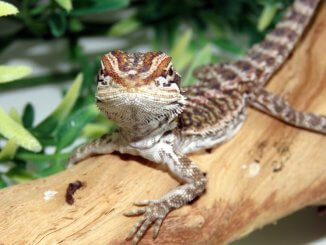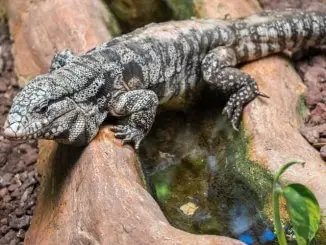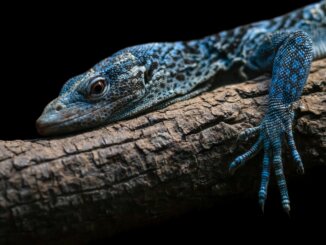There are seven different types of bearded dragon poop.
Healthy bearded dragon poop is brown and white. But, sometimes it can be watery, runny, bloody or yellow.
It is important you know which poop is healthy and which is not.
Color, texture and frequency of discharge are all vital health indicators.
Though it may not sound too pleasant, keeping an eye on a bearded dragon’s feces is one of the best ways to learn about their health.
If you want to learn more about how often a bearded dragon should poop, what it should look like, and how to make them poop then keep reading!
How Often Should A Bearded Dragon Poop?
Adult bearded dragons should poop at least once per week. However, some individuals can poop up to seven times a week. Diet, age, hydration, environment, illness and stress can all influence a beardie’s poop schedule.
A Bearded dragon that eats lots of calcium-rich foods (e.g. silkworms) will usually poop more often.
This is quite common with babies and juveniles as they need a protein based diet. Adults on a vegetable diet will tend to poop less.
Bearded dragons will also poop more or less depending on how old they are. Babies tend to poop more often than juveniles or adults:
- Babies can poop up to three times per day but should poop at least once a day.
- Juveniles will usually go once every other day.
- Adults will go from one to seven times per week.
Illness will also affect their frequency.
Parasitic infections can sometimes be responsible for a bearded dragon pooping a lot or being constipated.
Environmental factors and stress levels normally result in a bearded dragon pooping less. Aggression and biting are common signs of stress. Stress can result from a wide range of factors such as tank relocation, loud noises and habitat changes. If this happens you should try to locate and remove the source of their stress.
Excessive moisture and water in a bearded dragon’s habitat can increase their stress levels too.
Fluctuations in UVB light levels can also interfere with their digestion causing inconsistency and reduced pooping.
What Should Bearded Dragon Poop Look Like?
A Bearded Dragon’s poop should be brown with white urate. If a bearded dragon is healthy their stool will be brown, firm in consistency and log shaped. Urate will be either white or yellow and usually remains at the end of the poop.
The white portion of the poop is called urate and it should be soft in consistency and not smell foul. Bearded dragons do not pee. Instead they pass urate – a uric acid paste. Secreting this uric acid allows them to get rid of the nitrogenous waste in their bodies whilst conserving water.
Some changes in poop color are not a cause for concern and are relatively common.
If you notice changes in the consistency, odor, or amount of poop then try and check for the causes. Changes when paired with other factors such as lethargy, loss of appetite are a cause for concern.
Healthy Bearded Dragon Poop
Normal bearded dragon poop is brown and white. The brown portion of the poop should be log shaped and the white portion should be at the sides or end of the brown part.
Poop and urate are passed simultaneously so you should always see them together.
If your beardie’s poop meets the description above then you have a healthy pet.
This is the color and consistency you want your pet to have.
Bearded Dragon Runny Poop
Diarrhea can severely dehydrate a bearded dragon.
Diet changes, bad diet and parasites are the three biggest reasons for bearded dragon diarrhea. Parasites can pose a big health problem if they are not taken care of quickly.
If you have just changed your beardie’s diet and notice runny stool it should settle down in a couple of days.
Feeding foods high in fiber (e.g. apples and pumpkin) can result in runny stool as well. To fix this slowly reduce the amount of high fiber foods in their diet. Remember, vegetables should compose 75% of their diet. Fresh fruits and greens have a lot of water that can result in your pet becoming overly hydrated.
Runny poop can also indicate parasites.
The most common way bearded dragons get parasites is from the insects they eat. Insects can contain parasites which are passed on when they are consumed.
Signs a bearded dragon has a parasitic infection include:
- Mucus in stool
- Weight loss
- Lethargy
- Loss of appetite
- Anorexia
- Foul smell coming from the poop
Bearded Dragon White Poop
Chalky white poop usually means that a bearded dragon is dehydrated. String-like saliva, in addition to chalky white poop, is a symptom of mild dehydration.
Mild dehydration is very easy to fix.
You should place them in short 15-minute baths. This can help to moisten their skin and rehydrate. After rehydrating make sure your beardie is drinking enough water and that the tank temperature is not above 105℉.
If left untreated dehydration can lead to serious illness.
A bearded dragon that has multiple chalky white stools should be taken to the vet.
If your dragon is only excreting the urate part of their poop this can mean they are overly hydrated or have not had much food recently. In both cases make sure they are not experiencing any loss of appetite and offer some food.
Blood In Bearded Dragon Poop
Red Bearded Dragon Poop can be a result of something your dragon has recently eaten. Their stool could be red if they were given raspberries or beets. Do not mistake this for blood.
Traces of blood in their poop can be a sign of a serious issue (e.g. internal bleeding or parasites).
If a bloody stool happens just once it should not be a cause for concern. Though one occurrence is not an immediate cause for concern, it is best to stay vigilant. You should closely monitor and observe their poop over the next few days.
Internal bleeding can be a result of foreign objects or bugs with sharp legs tearing their intestine. Parasites (specifically Coccidia) can also rupture the wall of the intestine. Lethargy and loss of appetite are also symptoms of a parasitic infection.
Bloody poop is something that should never be dismissed or ignored.
In either case of internal bleeding or parasites you should take a stool sample to your vet.
Yellow Bearded Poop
Yellow poop can be a result of too much calcium in a bearded dragon’s diet. Too much calcium can cause bowel problems, organ damage and will lead to liver disease.
Bearded dragons need different amounts of calcium depending on how old they are:
- Hatchlings should have a calcium supplement daily.
- Juveniles every other day.
- Adults at least once a week.
If you notice your beardie’s poop is yellow then you need to reduce their calcium intake.
First make sure that the UVB tube does not cover the entire length of the tank your beardie lives in. It is important that your reptile can move in and out of the UVB light as they need it.
UVB light helps your lizard make vitamin D and Vitamin D promotes the absorption of calcium. Too much calcium and excessive UVB exposure are bad for a bearded dragon’s health.
If light is not an issue then consider their diet.
Your bearded dragon gets calcium from certain foods (e.g. kale and watercress) as well as dusting food with calcium powder.
Food that is high in calcium and calcium supplements can cause yellow poop.
Depending on your Beardie’s age you can consider taking away the calcium supplement for a few days to a week.
Yellow Substance That Is Not Poop
Yellow substances specific to a female could be excretion of an infertile egg. If you suspect this do not pull on the egg. Yellow substances specific to a male can be a seminal plug. This is often tinted yellow and string-like in texture. A bath and gentle massage should do the trick in helping both issues.
Black Bearded Dragon Poop
Black poop can happen when you feed too many insects and not enough vegetables. Chopped plants and vegetables should always be included in a bearded dragon’s diet. Active adults should eat plant materials two to three times a week.
If your beardie is eating a good amount of leafy greens and still has black stool, then you will need to get the stool examined.
Back poop can be a sign of impaction. Impaction is blocked bowel movements that can result in tears, internal bleeding and severe constipation.
Watery black stool that is foul smelling can also be a parasitic infection.
Do keep in mind that fecal waste in a bearded dragon’s environment will begin to darken naturally after a few hours.
Green Bearded Dragon Poop
Green poop is normally a result of green dye in their food. Green leafy vegetables can stain your beardies poop and make it appear green. It is completely normal.
If your bearded dragon is acting normally then do not worry too much about the occasional green poop.
In some rare cases, where the green poop is runny and has a foul odor, it has been associated with liver disease, anorexia and hemolytic anemia. If you suspect this then contact a vet.
Bearded Dragon Poop Chart
| Poop color | Explanation | |
|---|---|---|
| Brown and White | Normal | This is what bearded dragon poop should look like. |
| Chalky White | Usually dehydration | If not rehydrated properly it can lead to illness. |
| Red or Bloody | Dye from red foods or impaction and parasites | Impaction and parasites can indicate an unhealthy beardie. |
| Yellow | Too much calcium | Usually not anything to worry about provided calcium intake is reduced. |
| Black | Feeding too many insects | If you are feeding leafy greens and the stool is still then it needs examining. |
| Green | Usually dye from green foods | Staining from vegetables is normal and still indicates a healthy pet. |
How Long Can A Bearded Dragon Go Without Pooping?
Healthy bearded dragons not in brumation should not go for longer than one week without pooping. Some individuals can go several weeks without pooping, but, this will be very painful and is normally a sign of a health issue.
There are six main reasons for why a bearded dragon is not pooping:
- A poor diet
- Parasites
- Stress
- Lighting
- Impaction
- Brumation
Poop is usually passed four or five days after a feed. This can vary based on the age and species of bearded dragon. An improper diet can affect their digestive systems and cause them to become constipated.
Parasites can cause your bearded dragon to stop pooping completely. Pinworms can lead to constipation and cloacitis. Regular husbandry and tank cleaning is key to preventing them.
Stress can also result in constipation. A bearded dragon can experience stress due to a variety of different reasons. The most common ones are environmental reasons such as UVB light and water.
It is vital that your bearded dragon gets the appropriate amount of light each day. A UVB bulb should be used with a UV meter to monitor it. Let a bulb warm up for about fifteen minutes and then use the UV meter to measure it. Ideally you want the reading to be over 100 uW/cm^2.
UVB bulbs should be paired with an infrared bulb for basking and replaced every six months.
Finally, during brumation a bearded dragon will poop a lot less than usual. Brumation is a period where bearded dragons are less active due to cooler temperatures. It can last up to three months.
How To Make A Bearded Dragon Poop
If your Bearded Dragon is constipated the best thing you can do is to give them a bath.
The bath should last about 15 minutes and use warm water – rather than hot. Gently massaging their stomach every five minutes during the bath will also help. A warm bath can work wonders in helping your beardie poop!
If this doesn’t work, then some natural remedies can be used.
Start by adding soft foods into their diet and avoid feeding insects. Pumpkin puree diluted with water is a great option. If your bearded dragon is reluctant to eat it then try placing it on their nose.
Another possible way to get your bearded dragon to poop is to place a few drops of olive oil on their nose. When they lick it off it should act as a laxative.
Summary
There are seven different colors and types of bearded dragon poop.
Brown and white stool indicates a healthy and happy Beardie! Their poop should stay brown and white provided they have minimal stress, the correct diet and a good setup.
Red, Yellow and Black stools can indicate a serious health problem.
If you are worried about your bearded dragon’s poop then do not hesitate to contact a vet. They will perform a fecal flotation to see if there is a problem.
Monitoring their poop is not something you want to constantly think about. But, it is simple, easy and helps you to understand their health.




I have a beaded dragon and he has not pooped in a week and half. My wife takes care of him and she is concerned about him and he stopped eating veggies he only eats worms.
Hi Grady, what substrate do you use for your Beardie? Is it possible they may have impaction?
I have a 4 months old bearded dragon I feed him crickets, but can I feed him something else?
Tons of things!! I wish I could post a pic on here because I have saved pictures that people sent me to help me
Rubia roaches, BSFL, crickets, silkworms and then tons of veggies ( although mine isn’t eating veggies yet. I need to go get some bee pollen to entice him to!
i gave my year old beardie Dubai Roaches and his poop has been runny ever since. if it just typical for a small food switch up or is it a sign of impaction or parasites?
It could just be from the diet switch. If it is still runny after a few days, I would go to the vet for a parasite check. Impaction doesn’t cause runny poops.
I just got a 1-2 month old baby bearded dragon. I’ve had him for 2 days and have not sighted a poop yet. He eats pin crickets and a small amount of silver beet. How long should I wait to be concerned?
Hopefully he went through that process by now. 2 days is not long enough to worry, but keep in mind that baby dragons can injest substrate which can cause impaction (and thus no or little feces). This however, will cause other visible signs.
Choosing the right substrate, providing correct amounts of calcium and other nutrients, and feeding them in a safe environment are all potential options to deal with this risk. However, as said in the beginning, you might have just missed his first poop or you had to wait a little bit longer.
The urate portion of karols poop was lards and hard after brumation is this cause for concern?
This fact alone should not be cause of concern. You would probably have to consider these factors: how many times has this happened? how much has she been eating? how long was she in brumation? Could she be a little dehydrated?
Behavioral and physical adjustments are normal after brumation and it may take a little while for dragons to fully wake up and go back to normal.